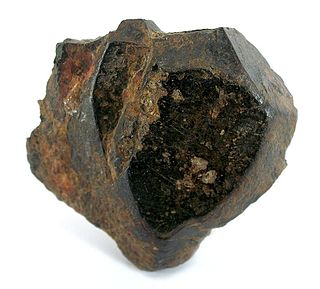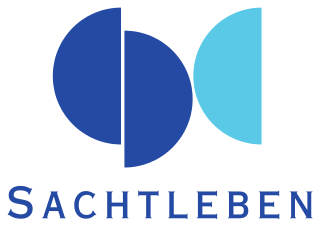
Titanium is a chemical element; it has symbol Ti and atomic number 22. Found in nature only as an oxide, it can be reduced to produce a lustrous transition metal with a silver color, low density, and high strength, resistant to corrosion in sea water, aqua regia, and chlorine.

Ilmenite is a titanium-iron oxide mineral with the idealized formula FeTiO
3. It is a weakly magnetic black or steel-gray solid. Ilmenite is the most important ore of titanium and the main source of titanium dioxide, which is used in paints, printing inks, fabrics, plastics, paper, sunscreen, food and cosmetics.

Crimea is a peninsula in Eastern Europe, on the northern coast of the Black Sea, almost entirely surrounded by the Black Sea and the smaller Sea of Azov. The Isthmus of Perekop connects the peninsula to Kherson Oblast in mainland Ukraine. To the east, the Crimean Bridge, constructed in 2018, spans the Strait of Kerch, linking the peninsula with Krasnodar Krai in Russia. The Arabat Spit, located to the northeast, is a narrow strip of land that separates the Syvash lagoons from the Sea of Azov. Across the Black Sea to the west lies Romania and to the south is Turkey. The population is 2.4 million, and the largest city is Sevastopol. The region has been under Russian occupation since 2014.

Titanium dioxide, also known as titanium(IV) oxide or titania, is the inorganic compound derived from titanium with the chemical formula TiO
2. When used as a pigment, it is called titanium white, Pigment White 6 (PW6), or CI 77891. It is a white solid that is insoluble in water, although mineral forms can appear black. As a pigment, it has a wide range of applications, including paint, sunscreen, and food coloring. When used as a food coloring, it has E number E171. World production in 2014 exceeded 9 million tonnes. It has been estimated that titanium dioxide is used in two-thirds of all pigments, and pigments based on the oxide have been valued at a price of $13.2 billion.
Huntsman Corporation is an American multinational manufacturer and marketer of chemical products for consumers and industrial customers. Huntsman manufactures assorted polyurethanes, performance products, and adhesives for customers like BMW, GE, Chevron, Procter & Gamble, Unilever and Walkaroo. With global headquarters in The Woodlands, Texas, it operates more than 60 manufacturing, R&D and operations facilities in over 25 countries and employ approximately 7,000 associates across three business divisions. Huntsman Corporation had 2023 revenues of approximately $6 billion.

The Syvash or Sivash, also known as the Putrid Sea or Rotten Sea, is a large area of shallow lagoons on the west coast of the Sea of Azov. Separated from the sea by the narrow Arabat Spit, the water of the Syvash covers an area of around 2,560 km2 (990 sq mi) and the entire area spreads over about 10,000 km2 (3,900 sq mi). The Henichesk Strait is its eastern connection to the Sea of Azov. The Syvash borders the northeastern coast of the main Crimean Peninsula. The central and eastern Syvash were registered as wetlands of Ukraine under the Ramsar Convention. Since the 2022 Russian invasion of Ukraine, the entire Syvash has been occupied by Russia.

Armiansk is a city of regional significance in the northern Crimean peninsula. The status of Crimea is disputed by the two countries since February 2014. Armiansk is located on the Isthmus of Perekop and serves as the administrative center of the Armiansk Municipality. Population: 21,987 .
Armiansk City Municipality is an administrative territorial entity of the Autonomous Republic of Crimea. Population: 24,415 .
Wellesley is a locality in the Bunbury region of Western Australia, about 10 km north-east of Australind. Its local government area is the Shire of Harvey. It is bordered on the south and east by the Brunswick River and the Wellesley River. The main feature of the locality is the Kemerton Industrial Park.

FC Tytan Armiansk was a football club based in Armiansk, Autonomous Republic of Crimea. The club last played in the Persha Liha during the 2013–14 season. The club was dissolved due to the annexation of Crimea by the Russian Federation.

The Crimean Bridge, also called Kerch Strait Bridge or Kerch Bridge, is a pair of parallel bridges, one for a four-lane road and one for a double-track railway, spanning the Kerch Strait between the Taman Peninsula of Krasnodar Krai in Russia and the Kerch Peninsula of Crimea. Built by the Russian Federation after its annexation of Crimea at the start of 2014, the bridge cost ₽227.92 billion (US$3.7 billion) and has a length of 19 km (12 mi), making it the longest bridge in Europe and the longest bridge ever constructed by Russia.
Dmytro Vasylovych Firtash is a Ukrainian businessman who heads the board of directors of Group DF. He was highly influential during the Yushchenko administration and the Yanukovych administration. As a middleman for the Russian natural gas giant Gazprom and with connections to the Kremlin, Firtash funneled money into the campaigns of pro-Russian politicians in Ukraine. Firtash obtained his position with the agreement of Russian president Vladimir Putin and, according to Firtash, Russian organized crime boss Semion Mogilevich.
This is a list of countries by titanium sponge production based on USGS figures. The production figures are for titanium sponge, units are in metric tons.

Pavlo Valentynovych Lebedyev is a Russian and former Ukrainian politician, financier and businessman who is currently a member of the Board of Russian Union of Industrialists and Entrepreneurs (RUIE). Head of Coordination Council of the Crimean branches of RUIE.
British Titan Products was the manufacturer of Tioxide, a brand of white yet opaque pigment and whitening agent made from titanium dioxide. It was initially organised to replace titanium dioxide supplies that British paint manufacturers imported from Germany. This British industry was established as a joint venture in 1934 by two of the world's major mining and chemical businesses in conjunction with a major industrial consumer and a distribution business.

Sachtleben Chemie is a chemicals producer, with its primary focus on the production of white pigments, fillers and extenders. The company employs some 2,200 persons and achieves annual sales of around 820 million euros (2012). Sachtleben has been a member of the multinational Venator group since 2017. The company's corporate history reaches back over 130 years. Sachtleben produces particles using titanium dioxide, zinc sulfide and barium sulfate as the chemical basis, and markets these products worldwide. The principal applications for Sachtleben products include man-made fibers, paints and other coatings, plastics, and paper. Sachtleben also supplies special particles to the foodstuffs, pharmaceuticals and cosmetics industries, and has interests in the fields of chromatography, nanotechnology, catalysis, and the production of building materials. The company leads the world in special titanium dioxide grades for printing inks and for the cosmetics, pharmaceuticals and food industries. The production facilities at all three locations apply the sophisticated sulfate-route process.

Vladimir Andreyevich Konstantinov is a Crimean and Russian politician who has served as the Chairman of the State Council of the Republic of Crimea since 17 March 2014.

In February and March 2014, Russia invaded the Crimean Peninsula, part of Ukraine, and then annexed it. This took place in the relative power vacuum immediately following the Revolution of Dignity. It marked the beginning of the Russo-Ukrainian War.

On 8 October 2022, at 6:07 a.m., a fire broke out on the Crimean Bridge as a result of an explosion of a bomb loaded onto a truck, which occurred on the road bridge, on the westbound vehicle lanes running from Russia to Kerch in Russian-occupied Crimea. Two two-lane vehicular spans of the bridge collapsed into the water. Two adjacent eastbound lanes on a separate structure survived. The railway bridge was also damaged by a railway tanker car that caught fire. Five people were killed. Following the incident, the Investigative Committee of Russia launched an investigation.

Valentin Valentinovich Demidov, is a Russian politician who is currently the 8th head of Belgorod, since 17 January 2023.














